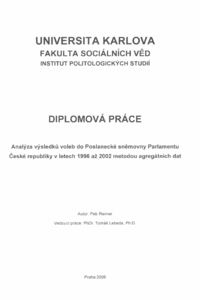Analýza výsledků voleb do Poslanecké sněmovny Parlamentu České republiky v letech 1996 až 2002 metodou agregátních dat
The analysis of elections to the Chamber of deputies of the Czech republic between 1996 and 2002 by aggregate data method
diplomová práce (OBHÁJENO)

Zobrazit/
Trvalý odkaz
http://hdl.handle.net/20.500.11956/6788Identifikátory
SIS: 1794
Kolekce
- Kvalifikační práce [17588]
Autor
Vedoucí práce
Oponent práce
Novák, Miroslav
Fakulta / součást
Fakulta sociálních věd
Obor
Politologie
Katedra / ústav / klinika
Katedra politologie
Datum obhajoby
26. 6. 2006
Nakladatel
Univerzita Karlova, Fakulta sociálních vědJazyk
Čeština
Známka
Velmi dobře
Volby do Poslanecké sněmovny Parlamentu České republiky v letech 1996 až 2002 byly charakteristické postupným poklesem volební účasti, poklesem počtu parlamentních uskupení, které překročily požadovanou pětiprocentní hranici podpory, či zmenšující se mírou územní variability stranické podpory politických stran. Ve sledovaném období je rovněž rozeznatelná odlišnost územní volební podpory pravicových a levicových stran. Podle provedených analýz by bylo možné rozdíly v územním rozlišení elektorátu vysvětlit socioekonomickými charakteristikami jednotlivých okresů. Mezi všemi stranami zároveň v provedených srovnáních vykazoval největší míru specifičnosti elektorát KDU-ČSL, jejíž podpora byla na rozdíl od ostatních stran spíše regionálně zakotvena s důrazem na míru religiozity daných okresů. Provedená analýza agregátních dat umožnila vyslovit soudy o vztahu podpory stran a územních charakteristik daných regionů, nedovolí však interpretovat výsledky jako důsledek volebního chování jednotlivých voličů. Takové soudy je s určitou mírou přesnosti možné vyslovit na základě výzkumů veřejných mínění, s jejichž závěry je předložená práce do značné míry ve shodě ohledně důležitosti role ekonomických faktorů jako determinantů politických preferencí. Relevanci takového závěru však bude ještě muset podpořit delší řada...
2002 were accompanied by a gradual decrease of voter turnout, decrease in the number of parties that exceed the five-percent threshold and by a decrease in regional variability of party support. In that period we could also distinguish a substantial regional dissimilarity of support between left-wing and right-wing parties. According to the following analysis we could explain those differences by various socioeconomic parameters of electoral districts. The most specific electorate among all parliamentary parties could be indentified with the Christian Democrats, whose support is regionally based and positively correlated with the regional rate of religiosity. The analysis of aggregate data allows us to explain the relation between party support and regional characteristics of electoral districts but does not permit explanation of the motives of individual voting behavior. Those conclusions could be made on the basis of public opinion research. This analysis is in general in accordance with the findings of research agencies, concerning the role of economic parameters as the main explanation factors of party support. Nevertheless, the relevance of this statement still remains to be grounded on a longer series of election data. Powered by TCPDF (www.tcpdf.org)
